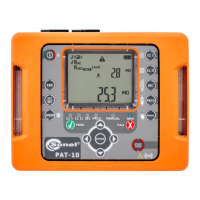1 Safety
The PAT-1, PAT-2, PAT-2E and PAT-10 testers are designed for performing check tests on electrical
equipment, providing measurement results which determine the safety status of tested devices.
Therefore, in order to provide conditions for correct operation and the correctness of the obtained re-
sults, the following recommendations must be applied:
Before you commence operating the tester, acquaint yourself thoroughly with the present manual
and observe the safety regulations and specifications determined by the manufacturer.
Any application that differs from those specified in the present manual may result in a damage to
the device and constitute a source of danger for the user.
PAT testers must be operated only by appropriately qualified personnel. Operating the tester by
unauthorized personnel may result in damage to the device and constitute a source of danger for
the user.
The instruments must not be used with installations or equipment situated in dangerous
environments, e.g. where fire or explosion hazards exist.
It is forbidden to operate the following:
A damaged tester which is completely or partially out of order,
A tester with damaged test leads insulation,
A tester stored for an excessive period of time in disadvantageous conditions (e.g. excessive
humidity). If the tester has been transferred from a cool to a warm environment with a high
level of relative humidity, do not start measurements until the tester is warmed up to the
ambient temperature (approximately 30 minutes).
The tester may be powered only from grounded mains sockets. The tester can’t be powered from
other sources than those mentioned in this manual.
Before starting any measurement, make sure the test leads are connected to the
proper test sockets.
Do not touch the tested device during measurements.
Test sockets and the socket for testing IEC cables are protected against improper
connection to the voltage up to 300V AC for 60 seconds.
Repairs may be carried out only by an authorised service point.
Using this manual does not exclude the need to comply with occupational health and safety regu-
lations and with other relevant fire regulations required during the performance of a particular type
of work. Before starting the work with the device in special environments, e.g. potentially fire-
risk/explosive environment, it is necessary to consult it with the person responsible for health and
safety.

